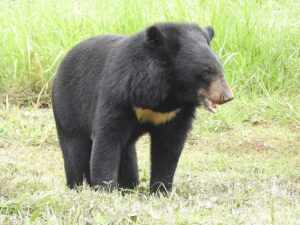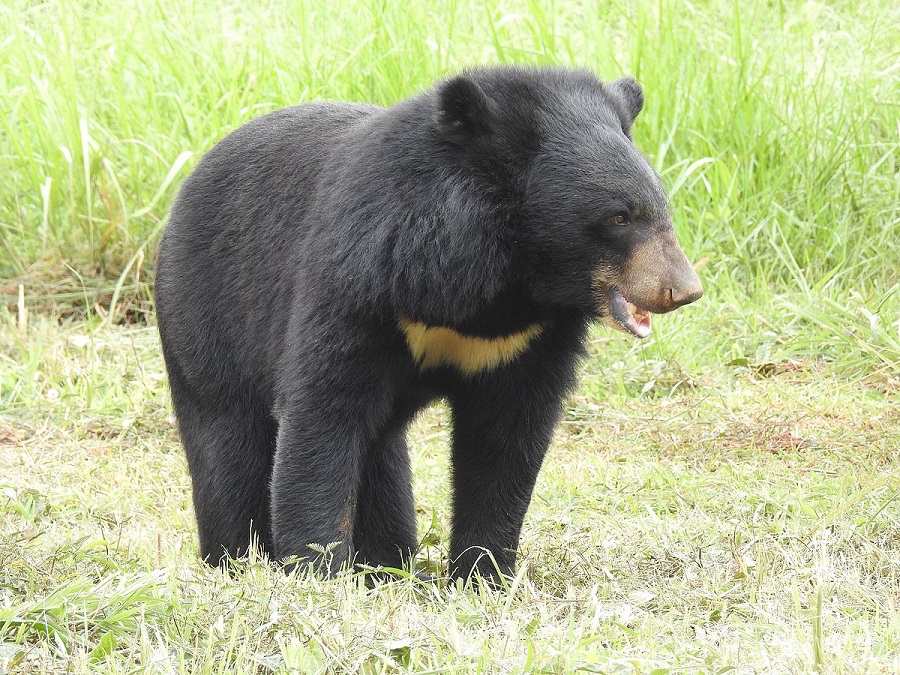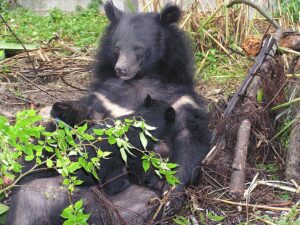Ursus thibetanus (Tibetan Bear)
Otherwise known as the Moon Bear, the Asiatic Black bear is a medium-sized bear that lives in Asia. It is a separate species to the American Black Bear, having diverged around 3 million years ago. They have a similar build to brown bears but are smaller, with slightly longer limbs. They have black fur, a light brown muzzle and a characteristic white patch on their chest, similar to that of the sun bear and earning them their common name of Moon Bear.
They are one of the most arboreal species of bear, spending around 15% per cent of their time in the canopy of trees. They have a powerful upper body that helps them climb.
Asian Black Bear Size
Moon Bears are medium-sized bears with males averaging 135Kg but getting up to 200Kg, and females growing to between 40 and 125Kg. They measure 70cm to 1m tall at the shoulder and are 1.2m to 1.9m in length.
Asian Black Bear Sub-Species
There are a number of different subspecies which we have listed below:
- Himalayan Black Bear – Found in Nepal, China, Kashmir and Tibet, they have longer, thicker fur and a smaller, whiter chest mark than the base species.
- Indochinese Black Bear – From the Himalayas and Indochina, they are similar to Himalayan Black bears but are lighter coloured.
- Tibetan Black Bear – Living in India, Nepal, Thailand, Myanmar and Vietnam, they have a short, thin coat with little underwool.
- Ussuri Black Bear – Found in Siberia, China and Korea, this is the largest sub-species.
- Formosan Black Bear – Living only in Taiwan they lack the thick neck fur of other subspecies.
- Pakistan Black Bear – From Pakistan, this is a small subspecies and often has reddish-brown fur.
- Japanese Black Bear – Found in Japan, this is also a small sub-species that lacks the thick neck fur of other black bears and has a darker coloured snout.
Asian Black Bear Habitat
Asian black bears are found in forested hills and mountains below 3,700m down to around 1,500m although in Japan they also inhabit sea level. Their range starts in Iran and Afghanistan and continues East across Asia through Pakistan, along the Himalayan foothills in India and Myanmar and through mainland South East Asia with the exception of Malaysia. They also have a patchy range in China, Korea and Southern Siberia and are found on the Islands of Japan and Taiwan. There are thought to be around 50,000 Asiatic black bears left but this figure is not entirely accurate.
Asiatic Black Bear Conservation
Asian black bears are classified as vulnerable on the IUCN Red List and their numbers are declining. There are a number of threats to these bears including deforestation and destruction of habitat to make way for agriculture, urbanisation and for logging; hunting for their parts, gall bladders and bile and conflict with humans over crop destruction. Conservation efforts are targeting illegal hunting and the protection of the bear’s forest habitats. It is thought that 10,000 bears are currently kept on bile “farms” in China and 2,400 in Vietnam, often in horrendous conditions.

Asian Black Bear Diet
Like most bears, the Asiatic black bear is predominantly vegetarian but their diet is very diverse, eating grass, fruits, berries, nuts, roots, honey, bees bests, rodents, lizards, termites, insects, eggs and carrion. They have also been known to kill wild boar, water buffalo and deer.
Asian Black Bear Adaptations
One of the main Asiatic black bear adaptations is that their front legs are much better developed than their back legs which means they are very adept at climbing trees – they are one of the largest arboreal animals in the world. They are also extremely well adapted to forage for and eat a huge variety of food, in stark contrast to the Panda for example.

Is the Asiatic Black Bear Dangerous?
There is a lot of different information about exactly how dangerous Asian black bears are. It seems they are generally quite peaceful in nature and will avoid conflict if possible but there are reports of people being attacked and killed by these bears which is becoming more common as humans encroach more and more on the bear’s habitat.
It is thought that Asian black bears are more aggressive than both Brown bears and American black bears. The reason for this is that, much like for the Sloth bear, these bears have to contend with tigers in the wild so they must be able to defend themselves against such powerful predators, this has likely transferred into how they deal with human threats. They have sharp teeth and claws so should be treated with respect. If you encounter a moon bear in the wild, do not agitate or scare the animal and do not run away as this may cause it to give chase. Instead calmly and slowly back away and the bear should leave you alone.
Asian Black Bear Predators
The main predator is the tiger. There have been several cases where predation has taken place but it is often not a one-way fight! Young bears will likely be killed by the tiger but once the bears get to around five years of age the tend to be relatively safe from attack. Asian black bears can be surprisingly ferocious when cornered and they are sometimes able to fight the tigers off. In addition, they are great climbers so the best course of defence is usually to run up a tree.
Black bears may also be attacked by the larger brown bear, although this is rare, and young bears are susceptible to attacks from leopards. Bears tend to dominate leopards when they are under tree cover but the opposite can be the case in the open.
Golden Moon Bear
Not much is known about the Golden Moon bear, but it is an extremely rare colour morph of the Asiatic black bear. It has a pale face, a dark brown “mane” and brown fur. Some individuals look a bit like a lion.
If you are interested in learning more about the American Black bear, you can check out our article here.
For more information about Sun bears, have a look at our article here.


